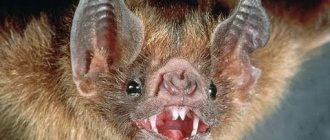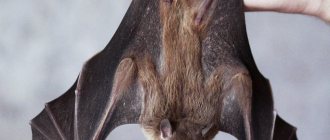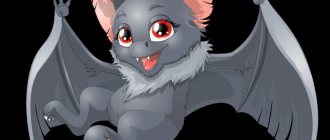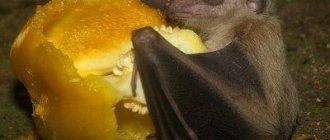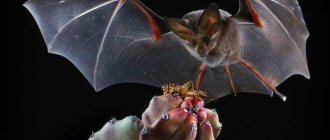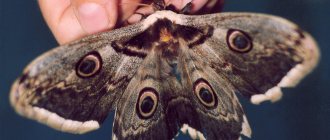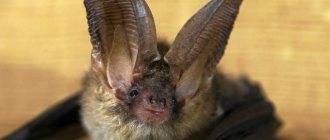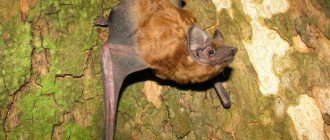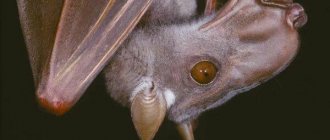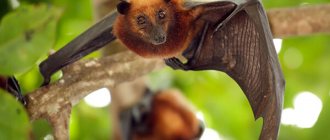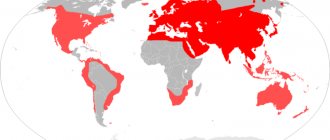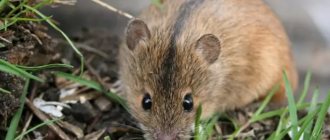Description of the species
The mammal belongs to the order Chiroptera, the family Smooth-nosed. Body 85-105 mm long. Weighs 40-75 g. The wingspan is 40-45 cm.
Shaggy, miniature mane at the back of the head. Color range: fawn-chestnut-red. The muzzle is wide, the eyes are large and graceful. The belly is slightly lighter than the back.
The wing is long and pointed: this anatomical feature contributes to the development of high speed. With the help of a thinner wing than that of birds, bats maneuver faster and more accurately.
At high speeds, the delicate upper limbs are often damaged, but then grow back. The structure of the ears is unusual - large, rounded, increased in width.
The auricle is directed forward, the tragus is mushroom-shaped. On the back of the wing, along the leading edge, a shiny woolen strip of tight-fitting fur grows.
The echolocation signal is strong, the maximum frequency is 19-23 kHz. Mammals are 8-9 years old; in the zoo, life expectancy almost doubles.
Fish
The ichthyofauna of reservoirs in the Samara region includes 56 species of fish from 13 orders and 18 families.
Species are categorized into orders and families. Order Sturgeons; Sturgeon family: Russian sturgeon, sterlet, beluga. Order Herring; Herring family: Black Sea-Caspian sprat. Order Salmonidae; Salmon family: brook trout; Whitefish family: peled, white fish (nelma), European vendace. Order Smelt-like; family Smelt: European smelt. Order Pike-like; Pike family: common pike. Order Eels; family River eels: river eel. Order Cypriniformes; Carp family: bream, bluefish, common white-eye, Russian bystryanka, southern bystryanka, common bleak, bighead carp, white silver carp, common asp, silver bream, golden crucian carp, silver crucian carp, Volga podust, white carp, common carp (common carp), common gudgeon , whitefin gudgeon, common verkhovna, chub, ide, common dace, saberfish, common minnow, common bitterling, common roach, rudd, tench; family Balitoridae: baleen loach; Loach family: common spined loach, loach. Order Catfish; Catfish family: common catfish. Order Codlike; Burbot family: burbot. Order Stickleback; Stickleback family: nine-spined stickleback. Order Acicularis; Needle family: plump-cheeked needle fish of the Black Sea. Order Perciformes; Perch family: common ruff, river perch, common pike perch, bersh; family Golovekovye: rotan-goloveshka; Goby family: star goby, sand goby, bighead goby, round goby, tsutsik goby. Order Scorpiformes; Slingshot family: common sculpin.
Pike is a formidable predator of freshwater bodies of water, feeding not only on fish, but also on amphibians and even birds.
Over the last century, as a result of anthropogenic impact, 12 species of cyclostomes and bony fish have disappeared from the ichthyofauna of the Samara region: thorn, Siberian sturgeon, stellate sturgeon, North Caspian bellyfish, anadromous Caspian herring, Caspian shad, and Caspian lamprey.
10 species of fish are included in the Red Book of the Samara Region: Russian sturgeon, sterlet, beluga, white fish, brook trout, bystryanka, Volga podust, common dace, whitefin gudgeon, and common sculpin.
Geographic range
A large and rare species of bat is found in deciduous and mixed forests, and selects old rotten tree hollows. Distributed: in Europe from Northern France to the Orenburg expanses of Russia, in cold climate zones: Moscow, Nizhny Novgorod regions, warm zones: Morocco, Iran, Transcaucasia.
It was found in the Kharkov region in 1956. Experts discovered a new find of five individuals in 2010 in the Dergachevsky district of the region and one specimen in Chernobyl. Since 2000, Ukrainian scientists have examined vast forests and captured about 14,500 flying representatives of the species.
The bat rehabilitation center believes that these individuals were not born here, but moved from the Voronezh region of Russia.
Giant Evening in the Red Book
This species of bat has been assigned a protected status in accordance with the annexes of the Bonn and Berne Conventions. Giant bats are listed in the Red Book of Russia and Ukraine.
Main causes of extinction
The main threats to the existence of the giant bat population are:
- human use of pesticides;
- destruction of broad-leaved forests;
- reduction in the number of insects that make up the food of noctules.
A close up of the small bat. Isolated on black.
Current population situation
It is difficult to determine the number of individuals of the giant noctule, mainly due to the peculiarities of the lifestyle of these mammals.
Observing bats in the Voronezh Nature Reserve, experts noted that for every 500 rufous noctules caught, there was one giant bat.
In the west of the Odessa region in Ukraine, during migration, out of 200 red mice, one giant one was noted. Approximately the same ratio was noted in the Rostov region during the capture of migrating animals.
According to rough estimates, the number of giant bats in Russia amounts to 17-27 thousand individuals. This number, according to experts, is small. Therefore, nocturnal winged mammals are rare species and are on the verge of extinction.
What measures were taken to protect
To attract noctule moths to the regions, it is necessary to stop the destruction of old-growth forests. After all, these mammals settle mainly in old plants.
Additionally, it is necessary to organize the creation of artificial shelters and conduct special research to identify migration routes and habitats of the noctule.
Features of behavior
The noctule's ultrasonic echolocation signals detect, localize, and classify prey in the darkness of the night.
Determining population trends is difficult, as is identifying mouse sanctuaries. Perhaps the factor of disturbance due to human activity is included.
During the day, the animal, like other bats, sleeps, hiding in a hollow tree or rock crevice. In winter - in caves and deep adits. If there is no old forest nearby, animals settle in parks and gardens.
Hunts over bodies of water. In summer, in a hollow, it gives birth to one cub, less often two. Animals are nocturnal - active in the evening and early morning. It is not known exactly where it spends the winter.
Red-haired nocturnal
Rufous noctule (Nyctalus noctula)
Class - mammals Order - bats
Suborder - bats Family - smooth-nosed bats
Genus - vespers
Appearance
One of the large bats. Body length 61-64 mm, tail - 46-54 mm. The wing is narrow and long. The color of the top is fawn-red or brown. The lower body is somewhat lighter.
Habitat
A widespread species, the range of which covers broad-leaved and mixed forests of Europe and South-Western Siberia, as well as various regions of Central Asia, Kazakhstan, China, East and Southeast Asia, the Middle East and Africa.
Lifestyle
Lives in deciduous forests with old trees, in parks and gardens. These mice settle in the hollows of old lindens and poplars, forming small groups of 30-35 individuals. During the day they sleep with their heads hanging down, and at dusk and at night they are active. During the night they make two feeding flights: the first after sunset, and the second at dawn. Rufous noctules hunt in forest clearings and forest edges. They fly quickly and maneuverably, deftly avoiding obstacles along the way, even in the dark. They feed on flying insects: beetles, butterflies. They use echolocation to search for prey.
In the European part of Russia, the rufous noctule is a migratory species, flying over long distances - up to 750 km, the record is 2347 km. The flight of rufous noctules to their wintering grounds begins at the end of August and ends in September. They fly in flocks or alone, without ceasing to feed. Most flights are made at night, but in good weather noctules can fly during the day. Sometimes bats fly with flocks of insectivorous birds, such as swallows. The spring migration of bats, like that of birds, takes place in a shorter period than the autumn migration. Arrival to summer habitats is observed from mid-April to the end of May. The females arrive first.
Reproduction
They breed in summer. The female usually brings two cubs, blind, naked, helpless. At first, they fly with their mother, clinging to her nipples, and when they are a little older, but not yet able to fly, they remain in the shelter. Young noctules grow quickly. With the onset of autumn, they fly away with adults to warmer places.
Captivity
One of the main difficulties when keeping bats in captivity is creating the necessary microclimate in their premises. Indeed, unlike most mammals, bats’ body temperature changes depending on the surrounding temperature, and is different in the state of sleep, wakefulness and in flight. These amazing creatures can even “sweat while shivering”, that is, increase their temperature due to muscle activity, expressed in the form of a kind of “shivering” when waking up from sleep... To rest, the animals require moderate coolness, but this same temperature can kill a well-fed bat , which must digest what it eats in a warm place before going to bed...
In their natural shelters, the animals themselves provide themselves with optimal conditions for a particular period, choosing the warmest or, conversely, the coolest corner of the cave, living alone or in entire clusters.
So it is necessary to arrange compartments for bats in which different temperatures and humidity are maintained, so that the animals themselves choose the most suitable conditions for themselves. To ensure the temperatures required in the cage, its ceiling is divided by partitions into a number of compartments 10-20 cm deep, in one of which a temperature of plus 30-35 ° C is maintained using a heater, while room temperature is maintained in the remote cold compartment. Electric lamps, tightly covered with a light-proof casing, or ceramic resistors with a power of 50-100 watts and a resistance of 15-20 kilo-ohms are used as heaters. The wooden walls of the cages, the ceiling and the slats that form the compartments are covered with fine stainless mesh, which allows the animals to move freely, clinging to it with their claws. The edges of the mesh must be sealed very carefully to avoid injury to animals and service personnel from the protruding ends of the wire.
The necessary humidity conditions are created by placing jars of water in different places in the cage, which also serve as drinking bowls. Animals that prefer high humidity usually roost above the water. Drinking bowls are placed near the walls and in the corners of cages so that animals can quench their thirst by going down to the water along the walls.
To keep 1-5 bats, it is enough to have a cage of 35 x 35 x 35 cm. In large cages, the animals are kept in entire colonies of 10-30. In general, it is better to keep bats from 2 to 30 individuals. These are social animals and feel better among their relatives. The floors of cages and cages are covered with paper, which is regularly replaced with clean paper.
A necessary condition for the good health of bats in captivity is their regular warm-up in flight. It is advisable to give animals that live in cramped cages the opportunity to run and move for at least 10-20 minutes before each feeding. For this purpose, animals can be released to fly around the room. If the cage or enclosure is spacious enough, it is not necessary to release the animals.
The basis of their diet in captivity consists of mealworms, pupae and adult beetles, as well as other insects. To make this food more complete, the worms are placed in small flat jars two to four days before feeding for an enhanced diet of protein and vitamin feed - fresh cabbage and carrots, raw and cooked meat, white bread soaked in milk. Before feeding, the worms are carefully separated from the remaining feed, sifting through a colander and discarding large residues with tweezers.
In addition to insects, the animals are periodically given milk mixtures from a pipette, which include milk (about a glass), chicken egg yolk, purified brewer's yeast or wheat bran (teaspoon), granulated glycerophosphate or calcium glycerophosphate (5 grams), honey or rose hip syrup (one teaspoon), vitamin E (two drops). Periodically add two or three crushed multivitamin tablets to the mixture. Insect feeding is done five times a week; milk formula is given periodically for a week in a row before feeding insects, after which a break of one to two weeks should be taken.
Newly received animals need to be given a drink of milk formula or at least water from a pipette, released into an enclosure to rest and clean themselves, then made to fly a little and only then fed with mealworms.
The first feedings are carried out in the hands, holding the animals in a natural position for a particular species and bringing a mealworm to their mouths. Some people refuse to eat worms at first. These have to be force-fed with worm juices, squeezing them directly into the animals’ mouths.
Animals that readily take worms can be fed on the first day by placing them in flat tin cans with beetleworm larvae sifted from the bran, which they take on their own. The sick and weakened have to be hand-fed, given milk mixtures, sometimes two or three drops of Cahors, and only then worms. Such bats are fed in small portions at least two to four times a day, while healthy ones only need to be fed once.
Fed animals can digest food only in warmth, when certain areas of the cells are heated to plus 30-35 ° C, otherwise putrefactive processes occur instead of digestive processes, which leads to the death of bats.
Bats are very voracious. With unlimited feeding, they are able to absorb up to 60 percent of their mass in one go, which they would hardly be able to do under natural conditions, when they would have to search for and catch every insect. Because of this, animals can systematically overeat, which leads to their death from indigestion or obesity. It is necessary to strictly limit their food intake, especially for newly arrived animals that have not yet adapted to the new conditions of detention.
With unlimited feeding, red noctules - up to 100 mealworms, but for their health they should be given half as much, and in the first days of captivity, 1/4 of the maximum dose is sufficient.
Under natural conditions in winter, most bats require hibernation at low environmental temperatures plus 3-7 degrees. In captivity, it is useful to keep healthy, well-fed animals in a state of hibernation during the winter for four to eight weeks. It has been noticed that hibernation gives the animals a kind of rest, relieves fatigue and stress.
Three days before hibernation, the animals are not fed; 48 hours in advance, they are placed in a hibernation room and gradually cooled to the desired temperature. During hibernation, the condition of the animals is regularly checked, judging it by the positions in which they hang, by their reaction to light noise and breath. In case of deviations from the norm, the hibernation of weakened animals must be interrupted.
To awaken the animals, they are transferred to a warm room, allowed to warm up and clean themselves, forced to fly and fed as for new arrivals, that is, by hand, with a milk mixture and a reduced portion of mealworms.
Diet
Not picky. Satisfied with what he catches. It is voracious and destroys small pests in large numbers. In summer it catches insects: butterflies, beetles, long-legged mosquitoes, and lacewings.
Feeding begins at nightfall and lasts until morning. During periods of famine, it flies a long distance in search of food. During mass bird migrations, the menu is enriched with the addition of the weak songbird.
In this way, members of the passerine family can fall into the paws: Robin, Chiffchaff, Warbler, Redstart. To detect a victim using ultrasound, it only takes 10-13 milliseconds.
The attack was not observed by anyone, probably due to the height. Nothing more is known about the hunters' tactics. This fact is proven by laboratory studies: in the feces of mice there were remains of bones and feathers of small birds.
Nutrition
Giant noctules hunt over forest edges and the surfaces of reservoirs. They start hunting at high altitudes and then descend closer to the ground. Food includes large beetles (rhinoceros beetles, longhorned beetles, beetles, stag beetles) and moths. Based on blood and droppings analysis, it was established that giant noctules feed on small passerine birds during their migration periods. It was established that their prey included robins, warblers, warblers and redstarts. However, attacks on birds have never been observed, probably due to the fact that hunting takes place at night at altitudes above 700 meters. How the hunting process itself occurs is also unknown.
Reproduction
Females are considered sexually mature after 4 months. The mating season begins in September. The male forms a harem of three to ten girlfriends. Then the pregnant women gather in large communities, most often with relatives - the rufous and lesser noctules, 20-30 individuals each - for the winter.
Groups are called brood colonies. So, all together they while away the time and feed the cubs. Babies are born in early summer. The baby weighs 6-7 grams, feeds on mother's milk, does not leave her at first, and clings tenaciously with its claws.
After a month they remain in the shelter, after 10 days they are already flying and soon become able to exist on their own.
Conservation status
It is very difficult to estimate the number of giant noctule due to the peculiarities of its lifestyle. The nature of human impact on this species is the same as on the lesser noctule. Special conservation measures have not been developed, and it is not clear what measures may be effective, since the reasons for the low numbers are unknown. Detailed studies are needed on the distribution and biology of the giant noctule. Now only protective measures can be proposed that are common to all bats: preserving habitats (old hollow deciduous trees), promoting conservation, and the like.
Source
Interesting Facts
It can populate oak, beech, birch, even pine, if there is nothing more suitable. The main thing is that the tree is old, with a spacious hollow inside.
Every autumn, over 4 billion birds migrate over the Mediterranean Sea. “Travelers” are mostly small, preferring at night so as not to encounter a falcon or other daytime predator on the way - which is easy prey for the giant noctule.
This fact prompted scientists to conclude that bats found a calorie reserve of food not so long ago. It is important to note that millions of years of evolution have taught them to find new ways to diversify their menu: arthropods, pollen, possibly blood are also suitable for food. Now here are the birds.
Very hardy - able to easily fly over high mountains and migrate long distances. They live in small groups of 2-3 individuals, rarely creating colonies.
When communicating with each other, they use ordinary sound signals. Attracting girlfriends, male specimens, sitting at the entrance to the dwelling, twirl with rattling voices. Unfortunately, human hearing is not capable of detecting these sounds.
In a number of European countries it is forbidden to photograph it or observe it closely. Spanish authorities adhere to especially strict savings rules, which consider the population to be the most vulnerable.
Where do they live?
Small and isolated populations of giant noctule live in the following areas:
- Southern and Eastern Europe;
- Middle East and Central Asia;
- North Africa;
- Asia (Kazakhstan, Uzbekistan, northern Iran).
The European population has a range ranging from the Pyrenees to Turkey. In Russia, the giant noctule can be found in the following areas:
- in Moscow;
- in Nizhny Novgorod;
- in Vladimirskaya;
- in Orenburgskaya.
Security
The nature of human impact on this species is the same as on the lesser noctule. Special conservation measures have not been developed, and it is not clear what measures may be effective, since the reasons for the low numbers are unknown. Detailed studies are needed on the distribution and biology of the giant noctule. Now only protective measures can be proposed that are common to all bats: preservation of habitats (old hollow deciduous trees), promotion of conservation, and the like [8].
Notes
- ↑ Sokolov V. E.
Five-language dictionary of animal names. Mammals. Latin, Russian, English, German, French. / under the general editorship of academician. V. E. Sokolova. - M.: Rus. lang., 1984. - P. 74. - 10,000 copies. - ↑
LARG - Giant noctule (Nyctaalus lasiopterus) - ↑ 12
Giant noctule - Nyctalus lasiopterus - ↑ 12
Giant noctule - Encyclopedia of mammals of the former USSR - ↑
Popa-Lisseanu, A.G., Delgado-Huertas, A., Forero, M.G., Rodriguez, A., Arlettaz, R. & Ibanez, C. (2007).
Bats' conquest of a formidable foraging niche: the myriads of nocturnally migrating songbirds
. PLoS ONE 2(2): e205. Text (engl.) - ↑
MEMBRANA | Giant mice eat migratory birds at night (printable version) - ↑
Panyutin K.K. Long-distance migrations of bats ringed in the Voronezh Nature Reserve / K.K. Panyutin // Animal migrations. - L, 1968. - Issue. 5. - ↑
GIANT PARTER (ORDER CHIMOPTERA)
